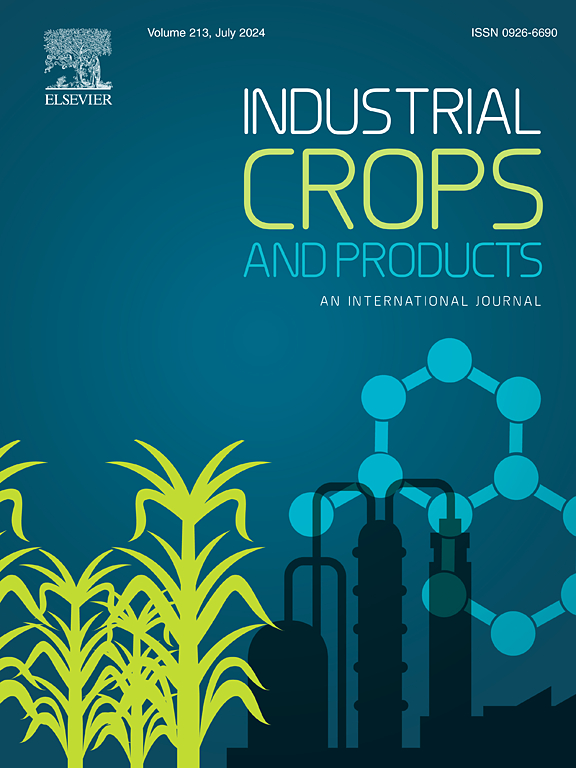Resequencing-based QTL mapping of girth and rubber yield traits in a full-sib rubber tree population GT1 × CATAS8-79
IF 5.6
1区 农林科学
Q1 AGRICULTURAL ENGINEERING
引用次数: 0
Abstract
Rubber tree (Hevea brasiliensis) provides the sole commercial source of natural rubber, a crucial industrial raw material. Rubber yield and girth are widely considered as the most important agronomic traits of rubber tree. However, due to the delayed initiation of rubber tree research, the identification of quantitative trait loci (QTLs) and candidate genes for these traits remains limited. Here, QTL mapping analysis was conducted on the full-sibling progeny population derived from a cross between the clones of GT1 and CATAS8–79. Phenotypes of girth, dry rubber yield (DRY) and yield per centimeter girth (YCG) were measured annually for four consecutive years. Meanwhile, the resequencing of 238 offspring individuals identified 29,140,529 high-confidence SNPs, which resulted in the generation of 3147 non-redundant bin markers. Based on these bin markers, 18 high-density linkage groups were constructed, with an average genetic distance ranging from 1.49 to 4.96 cM. Subsequently, a total of 37 environmentally stable QTLs were identified comprising 8 for girth, 16 for DRY, and 13 for YCG. These QTLs explained phenotypic variances spanning from 0.32 % to 17.71 %. The two most reliable QTLs, namely QGirth-4 and QGirth-7.2, were further investigated and 21 candidate genes were identified. Based on transcriptome sequencing and homologous annotation, a gibberellin receptor gene (GIBBERELLIN-INSENSITIVE DWARF1, GID1) was determined as the promising candidate for QGirth-7.2. Overexpression of HbGID1 led to early flowering and increased rosette-leaf branches in Arabidopsis, implying its significant role in girth development. These findings provide valuable insights into QTLs and target genes for enhancing growth and rubber yield traits, thereby contributing to molecular breeding of elite latex-timber rubber tree clones.
基于重测序的橡胶树全同父异母种群 GT1 × CATAS8-79 周长和橡胶产量性状 QTL 图谱分析
橡胶树(Hevea brasiliensis)是重要工业原料天然橡胶的唯一商业来源。橡胶产量和周长被广泛认为是橡胶树最重要的农艺性状。然而,由于橡胶树研究起步较晚,对这些性状的数量性状位点(QTL)和候选基因的鉴定仍然有限。在此,我们对 GT1 和 CATAS8-79 两个克隆杂交产生的全同胞后代群体进行了 QTL 图谱分析。连续四年每年测量周长、干橡胶产量(DRY)和每厘米周长产量(YCG)的表型。同时,对 238 个后代个体进行了重测序,确定了 29 140 529 个高置信度 SNPs,从而产生了 3147 个非冗余 bin 标记。根据这些二进制标记,构建了 18 个高密度连锁群,平均遗传距离在 1.49 至 4.96 cM 之间。随后,共鉴定出 37 个环境稳定 QTL,包括 8 个周长 QTL、16 个 DRY QTL 和 13 个 YCG QTL。这些 QTL 解释了 0.32 % 到 17.71 % 的表型变异。对两个最可靠的 QTL(即 QGirth-4 和 QGirth-7.2)进行了进一步研究,并确定了 21 个候选基因。根据转录组测序和同源注释,赤霉素受体基因(GIBBERELLIN-INSENSITIVE DWARF1, GID1)被确定为 QGirth-7.2 的候选基因。过量表达 HbGID1 会导致拟南芥提早开花并增加莲座叶分枝,这意味着它在周长发育中起着重要作用。这些研究结果为了解提高生长和橡胶产量性状的 QTL 和目标基因提供了有价值的见解,从而有助于乳胶木材橡胶树精英克隆的分子育种。
本文章由计算机程序翻译,如有差异,请以英文原文为准。
求助全文
约1分钟内获得全文
求助全文
来源期刊

Industrial Crops and Products
农林科学-农业工程
CiteScore
9.50
自引率
8.50%
发文量
1518
审稿时长
43 days
期刊介绍:
Industrial Crops and Products is an International Journal publishing academic and industrial research on industrial (defined as non-food/non-feed) crops and products. Papers concern both crop-oriented and bio-based materials from crops-oriented research, and should be of interest to an international audience, hypothesis driven, and where comparisons are made statistics performed.
 求助内容:
求助内容: 应助结果提醒方式:
应助结果提醒方式:


